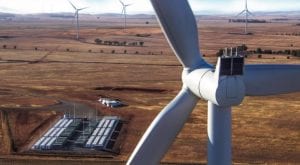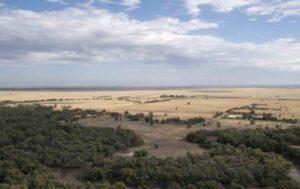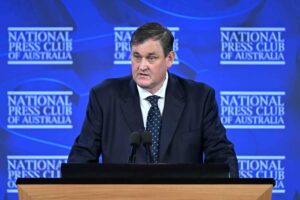Tilt Renewables, the trans-Tasman wind developer that is the subject of an agreed $2.8 billion takeover, has reported softer than expected earnings in its latest financial year, crimped by low wind conditions, low prices and the slower than hoped ramp up of its biggest asset.
Tilt will see its 800MW portfolio of operating assets, and its 5GW pipeline of wind, solar and storage assets split along geographic lines after agreeing to the bid from the Powering Australian Renewables fund and Mercury NZ.
Its biggest asset – following the billion-dollar sale last year of the 270MW Snowtown 2 wind farm – is the new 336MW Dundonnell wind farm in Victoria (pictured above), which was completed on time last March but has had its path to full production delayed by connection and commissioning delays the company blames on the market operator.
It is now operating all 80 turbines at Dundonnell, and even though its maximum output is still restricted by AEMO to 295MW, it says it is still able to deliver around 97 per cent of anticipated energy. It now may not get to full production capacity until the end of the year as it “tidies up modelling processes” with AEMO.
Other wind projects in Victoria have been more badly affected by connection and commissioning issues, particularly Goldwind’s heavily delayed 530MW Stockyard Hill wind project, and the 300MW Moorabool wind farm, which have not begun generation may not reach full production until next year.
“Development and construction of large-scale energy assets is a complex and challenging endeavour with uncertain outcomes that require solid commercial frameworks combined with experience and persistence to produce expected results,” Tilt said in a statement.
“Short duration delays during grid connection testing, like those experienced at Dundonnell are disappointing and have influenced short term earnings, but have minimal impact on the long- term value created by these 30 year assets.”
CEO Deion Campbell admitted to an “own goal” in the failure to install capacitors that will need to be integrated to deliver “reactive power” when the wind farm moves beyond 300MW, but expressed frustration at some of the processes, particularly those making it difficult to add battery storage.
Campbell also said the exact cause of the blade fall at Dundonnell last year had not been identified by supplier Vestas, but the turbines were now having “locking washers” installed on the turbine bolts as a precaution and this work had been completed on 2/3 of the turbines. “It is not just a problem facing Dundonnell,” Campbell said.
Tilt’s next project is likely to be the 396MW Rye Park wind farm in NSW, which has signed an offtake agreement with Newcrest Mining’s Cadia gold mine, and now has approval for increased “tip heights” that allows for bigger turbines, with a final investment decision within the next few months.
The current estimated cost is around $750 million, but this may be affected by steel costs, which are being driven higher by iron ore prices that Campbell noted had gone through the roof.
It has another 12 different project proposals in Australia, including the huge 1GW Liverpool range wind farm in NSW, and some battery storage projects.
Tilt reported earnings before interest and tax of $74.9 million for the year to March 31, down from $115 million last year (when Snowtown was included).
But its “comparable” earnings were up 18 per cent, and Dundonnell produced 633GWh and an Ebitda of $41 million, a return of around $65/MWh. Its off take agreements with Victoria, Snowy Hydro and Aldi have all kicked in the last six months.
Group revenue (excluding Snowtown) was up 18 per cent, mostly thanks to Dundonnell but also the new Waipipi wind farm in New Zealand, although average revenue per megawatt hour was lower due to lower electricity prices, particularly South Australia and Victoria, and falling renewable certificate prices
It noted the existing portfolio delivered softer production volumes, down 8 per cent in Australia and 9 per cent in New Zealand largely due to below average wind conditions.










